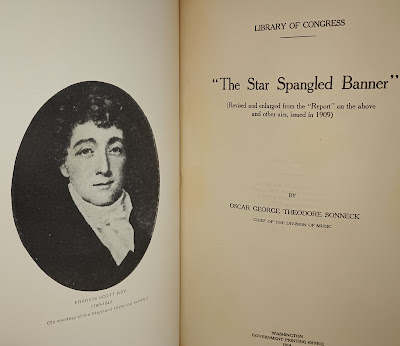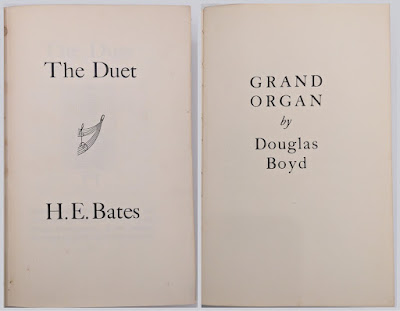Music in Literature resonated as the topic of the March 2024 meeting. The types of books presented were as varied as the styles of music depicted in them. The books ranged from literary to historical fiction and from nonfiction music criticism to personal memoirs. Genres of music ascended the scales from country to rock and roll to opera.
Sonneck, Oscar George Theodore. The Star Spangled Banner: Revised and
Enlarged from the Report on the Above and Other Airs, Issued in 1909. Washington DC: Library of Congress, 1914. Sonneck was the Chief of the Division of
Music for the Library of Congress and a renowned scholar of early music in
America. This volume on "The Star
Spangled Banner" provides a history of Francis Scott Key's text and the
various versions of music to which it was set.
It traces the evolution of the song and provides numerous facsimile
images of the text and music demonstrating the changes over time. Before Sonneck's detailed history of the song
which became the national anthem, the book first recounts in greater detail Francis
Scott Key's inspiration for writing the poem:
An unnamed gentlemen [Key] was waiting for
the release of a friend [William Beanes] from the British fleet who was
captured at Marlboro. He watched the
bombardment of Fort McHenry... and watched (from the riverbank of the Patuxent)
the American flag at the fort through the entire day... through the night (when
he could not see the flag) until the morning when he again saw the proudly
waving flag of his country.
This account is followed by the text of Frances Scott Key's
poem, without title, but only set to "Tune: Anacreon in Heaven."
 |
| Key's manuscript of "The Star Spangled Banner" |
 |
| No Want of Meat, Sir! |
Hackney, John. No Want of Meat, Sir!. London: Grayson & Grayson, n.d. [1936]. First edition. This scarce anthology contains twelve short stories published in 1935 in individual signed limited editions in The Grayson Books series, plus six additional stories not previously published. It contains two stories with a music theme, "The Duet" by H. E. Bates and "Grand Organ" by Douglas Boyd.
H. E. Bates's "The Duet" tells of a young boy, age 7 or 8, who hopes to have two renowned singers, a contralto and a bass, sign his autograph book. The distinguished performers completely ignore the boy, as they are more interested in each other. The Duet was first published in 1935 as the inaugural book in The Grayson Books series in a signed limited edition of 250 copies and has since been reprinted in Bates short story collections and other anthologies.
Douglas Boyd's "Grand Organ" tells of a man in a
quaint village in search of the source of entrancing organ music he hears one
day. The mysterious organist who built
the oversized instrument in an obscured barn eventually reveals himself to the
man who wants to hear it played. The
collector has been unable to find any other works by this author or any other
appearances of this short story. It seems
never to have been preprinted, existing only in this little-known, hard-to-find
anthology.
 |
| Music and Edgar Allan Poe |
Evans, May Garrettson. Music and Edgar Allan Poe. Baltimore: The John Hopkins Press, 1939. Illustrated frontispiece of a music score of “Eldorado”, a poem by Edgar Allan Poe. May Garrettson Evans was the first female reporter for the Baltimore Sun, where she also wrote as a music critic. Evans's book provides an annotated catalogue and criticism of the known musical settings of Poe's works as of 1939. Poe was not a musician in the ordinary sense of the word. He did, however, in both his poetry and prose possess a keen sense of subtle melody and rhythm which excited the musically inclined reader and inspired musicians and composers to set his works to music. No fewer than 252 songs, orchestrations, and operas were scored from Poe's poems and stories. “Annabel Lee” had been adapted most often, at 32 compositions, followed by "Eldorado" at 28.
 |
| Frontispiece image of "Eldorado" score and title page |
 |
| Rockabilly |
Ellison, Harlan. Rockabilly. New York: Gold Medal Books, 1961. First edition, paperback original. Ellison's novel follows poor, shy, country boy Luther Sellers, who is given the stage name Stag Preston by his ruthless promoter, on his meteoric rise to stardom with his rockabilly music. Stag's onstage persona and confidence creep into his real life and problems abound as he becomes more and more difficult to work with. Relationships and scandal entangle the star and his downfall is almost as swift as his rise to fame. Rockabilly was later retitled Spider Kiss.
 |
| Spider Kiss Left to right: Pyramid Books (1975), Ace Books (1982), Armchair Detective Library (1991), and M Press (2006) |
Ellison, Harlan. Spider Kiss. New York: Pyramid Books, 1975. Reissued with the new title.
. Spider Kiss. New York: Ace Books, 1982. This reprint was quickly withdrawn after
Ellison protested the use of a black-and-white photograph (instead of color) of
him on the rear cover and the classification of the book as Science Fiction on
the spine.
. Spider Kiss. New York: Armchair Detective Library, 1991.
First hardcover edition. The text is
offset from the 1975 Pyramid Books edition.
. Spider Kiss. Sherman Oaks, CA: M Press / Edgeworks Abbey, 2006. Reissue with cover art by Robert McGinnis.
Williamson, Malcolm.
Our Man in Havana: Opera in Three Acts. London: Josef Weinberger Ltd., 1963. Libretto by Sidney Gilliat; based on the
novel by Graham Greene. Australian
composer Malcolm Williamson adapted Greene's black comedy spy novel into a full
opera with seven principal characters and a supporting cast of 26 other
voices. Our Man in Havana was Williamson's
first full-scale opera, consisting of 8 scenes among 3 acts. It premiered at Sadler's Wells Theatre,
London, on July 2, 1963. This publication
includes the complete vocal score with piano accompaniment.
 |
| Sample score |
Tolkien, J. R. R. and Donald Swann. The Road Goes Ever On. New York: Houghton, Mifflin Co., 1967. "The Road Goes Ever On" is a
collection of walking songs sung by Bilbo Baggins on his adventures in The
Hobbit and The Lord of the Rings.
The song is first recited by Baggins in The Hobbit as he journeys
back to the Shire. Two variations of the
song appear in The Fellowship of the Ring and The Return of the King,
creating the song cycle. This book,
titled the same as Baggins's walking song, contains the words to the song cycle
taken from Tolkien's writings and the sheet music for the songs as scored by
British Composer Donald Swann. The song
cycle was first published in 1967, the same year an audio recording of the
music was released.
Tolkien, J. R. R. The
Silmarillion. London: George Allen
& Unwin, 1977. The Silmarillion
is a collection of variously styled stories, divided in five parts, written by
Tolkien and posthumously published by his son, Christopher. The first part, Ainulindalë, meaning "Music
of the Ainur," describes the creation of the world through music. The Ainur, a class of angelic beings, perform
great music which prefigures the creation of Eä, the material universe including
Middle-Earth.
Carswell, John. Tolkien’s
Overture: Concerning the Music of the Ainur. Franklin, TN: True Myths Press, 2018. Tolkien first wrote "Music of the
Ainur" in late 1919 through early 1920; he completely rewrote it in
1930. Carswell examines Tolkien's final
text and explores the role of music in his Middle-Earth legendarium. This copy is blind stamped as a limited
edition and hand numbered and signed by the author on the title page.

The Piano Shop on the Left Bank
Carhart, Thad. The
Piano Shop on the Left Bank. New York:
Random House, 2001. Carhart routinely
passed an unassuming storefront piano shop in Paris until his curiosity compelled
him to step inside. He slowly formed a friendship
with the shop's owner, who then introduced him to the hidden world of the
piano, including the craftspeople who make the pianos, how the instruments
work, the technicians who keep them tuned and working, and the musicians who
play them.
Pollack, Neal. Never
Mind the Pollacks: A Rock and Roll Novel.
New York: Harper Collins, 2003.
This "rock and roll novel" recounts the history of this genre
of music from the 1940s through the turn of the century through the lenses of
two rival music critics. The story
follows Neal Pollack, the only son of Jewish immigrant parents, through his
life in rock music from Memphis to Greenwich Village, from singer/songwriter to
music critic. Real-life musicians fill
the story, including Elvis Presley, Joan Baez, Iggy Pop, Bruce Springsteen,
Kurt Cobain, Joey Ramone, and others.
Heggie, Jake. The
End of the Affair: An Opera in Two Acts.
San Francisco: Bent Pen Music, Inc., 2009. Libretto by Heather McDonald, Leonard Foglia,
and Jake Heggie; based on the novel by Graham Greene. American composer Jake Heggie adapted Greene's
novel into a chamber opera with six principal characters and one non-speaking
character. It consists of a prologue and
8 scenes between two acts. The opera was
first performed by the Houston Grand Opera on March 4, 2004; it was revised twice
in subsequent performances by the Madison Opera (2005) and the Seattle Opera
(2005). Heggie is best known for his
operatic adaptation of Dead Man Walking (2000). He has also adapted Moby-Dick (2010)
and the 1946 film It's a Wonderful Life (2016). This publication of The End of the Affair
includes the revised vocal score with piano accompaniment.
 |
| Sample score |
Allman, Gregg with Alan Light. My Cross to Bear. New York: William Morrow & Company, 2012. Music icon and co-founder of the Allman
Brothers Band, Gregg Allman traces his life and career from his Georgia upbringing
to his life on the road with one of rock's greatest bands. Allman candidly writes about his youth and
his struggles with substance abuse, his failed marriages, including his brief
marriage to Cher, and the death of his brother, Duane Allman. This copy is signed by Allman on the half
title page.
Brandon, James. Ziggy,
Stardust and Me. New York: G. P.
Putman's Sons, 2019. First edition. Collins is an anxious 16-year-old trying to
cope with the real-world stresses of 1973, including the Watergate hearings and
Vietnam War. He creates an imaginary
world where he can escape reality.
Collins's fantasy safe haven is populated by David Bowie's Ziggy
Stardust and other musical characters as well as his deceased relatives,
including his mother. When Collins meets
Web, a Lakota teen, he finds a new form of escape, and his two worlds begin to
come together. The story is filled with
musical references from 1973; scenes are set with David Bowie's The Rise and
Fall of Ziggy Stardust and the Spiders of Mars and Aladdin Sane but
also the music of Sonny & Cher, Roberta Flack, Peter, Paul & Mary, and
other 1970s bands.
 |
| A Little Bit Country |
Kennedy, Brian. A Little Bit Country. New York: Balzer + Bray, 2022. First edition. Emmett performs at the Wanda World amusement park (a fictitious Dollywood) and wants to be country music's next superstar. Luke reluctantly takes a job at Wanda World to help pay his mother's medical bills. He hates country music because of the pain it has caused his family; his grandmother, Vera Rose, had a falling out with Wanda Jean Stubbs (a fictitious Dolly Parton). Emmett and Luke meet and begin to grow close, but a long-lost secret about Wanda Jean and Vera Rose surfaces and threatens Emmett and Luke's relationship. This copy is signed by the author on the title page.

Signed title page with bookmark and stickers














No comments:
Post a Comment